Operation Management: ERP and MRP Application Analysis Report
VerifiedAdded on 2022/08/08
|10
|2704
|18
Report
AI Summary
This report delves into the application of Enterprise Resource Planning (ERP) and Material Requirements Planning (MRP) in modern operation management, with a specific focus on their implementation within Amazon. It begins by defining ERP as a software solution that streamlines business management processes, highlighting its role in inventory management, purchasing, sales, manufacturing, financial management, customer relationship management, supply chain management, automated reporting, compliance monitoring, and IT optimization. The report then explores the benefits Amazon derives from ERP, including reduced operational and stock costs, and enhanced customer satisfaction. Furthermore, the report explains MRP as a component of ERP, emphasizing its use in production planning and inventory management. The report concludes by emphasizing the importance of ERP and MRP in managing various aspects of the supply chain and their role in eliminating manual planning, saving time, and improving productivity within business organizations.
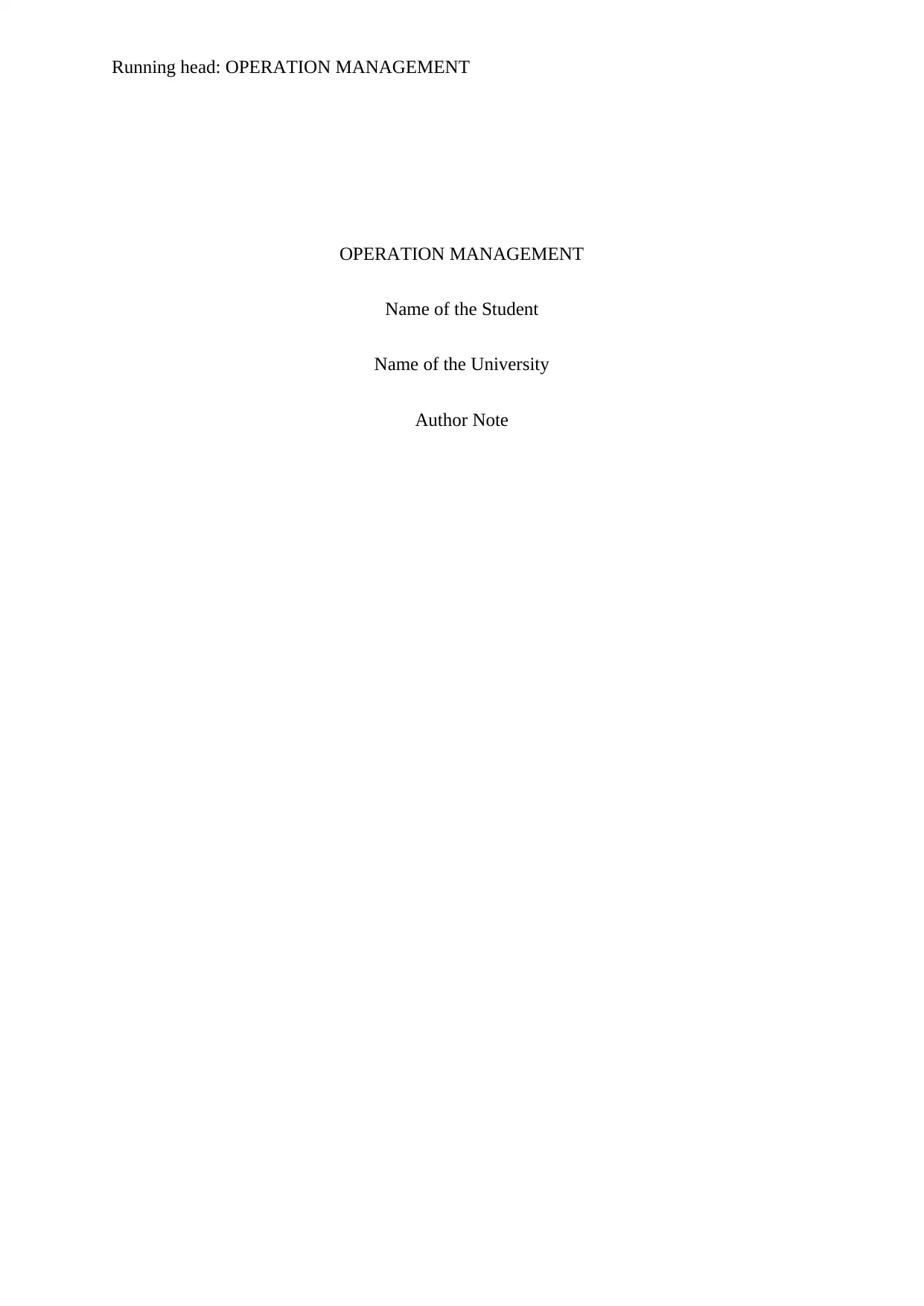
Running head: OPERATION MANAGEMENT
OPERATION MANAGEMENT
Name of the Student
Name of the University
Author Note
OPERATION MANAGEMENT
Name of the Student
Name of the University
Author Note
Paraphrase This Document
Need a fresh take? Get an instant paraphrase of this document with our AI Paraphraser
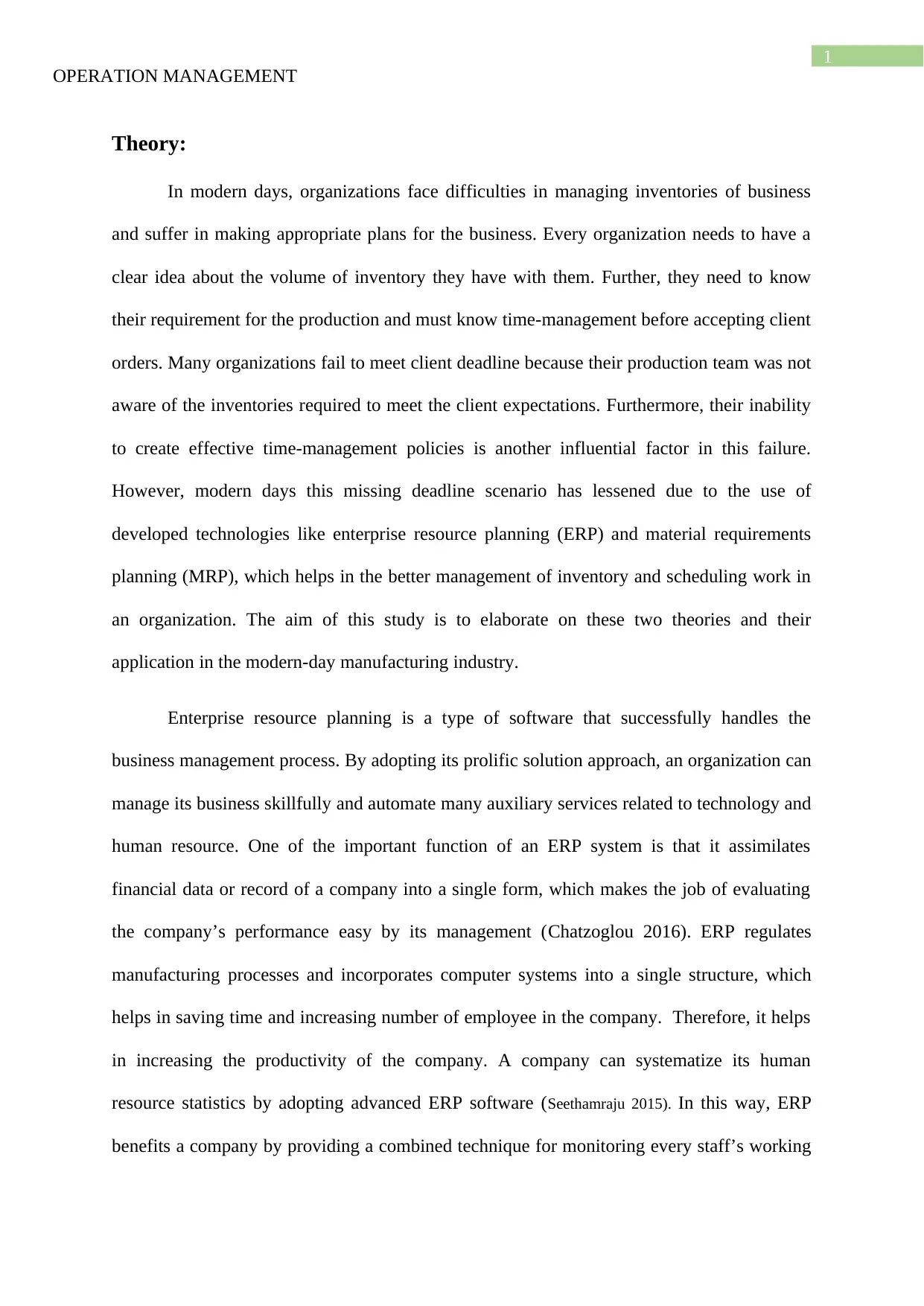
1
OPERATION MANAGEMENT
Theory:
In modern days, organizations face difficulties in managing inventories of business
and suffer in making appropriate plans for the business. Every organization needs to have a
clear idea about the volume of inventory they have with them. Further, they need to know
their requirement for the production and must know time-management before accepting client
orders. Many organizations fail to meet client deadline because their production team was not
aware of the inventories required to meet the client expectations. Furthermore, their inability
to create effective time-management policies is another influential factor in this failure.
However, modern days this missing deadline scenario has lessened due to the use of
developed technologies like enterprise resource planning (ERP) and material requirements
planning (MRP), which helps in the better management of inventory and scheduling work in
an organization. The aim of this study is to elaborate on these two theories and their
application in the modern-day manufacturing industry.
Enterprise resource planning is a type of software that successfully handles the
business management process. By adopting its prolific solution approach, an organization can
manage its business skillfully and automate many auxiliary services related to technology and
human resource. One of the important function of an ERP system is that it assimilates
financial data or record of a company into a single form, which makes the job of evaluating
the company’s performance easy by its management (Chatzoglou 2016). ERP regulates
manufacturing processes and incorporates computer systems into a single structure, which
helps in saving time and increasing number of employee in the company. Therefore, it helps
in increasing the productivity of the company. A company can systematize its human
resource statistics by adopting advanced ERP software (Seethamraju 2015). In this way, ERP
benefits a company by providing a combined technique for monitoring every staff’s working
OPERATION MANAGEMENT
Theory:
In modern days, organizations face difficulties in managing inventories of business
and suffer in making appropriate plans for the business. Every organization needs to have a
clear idea about the volume of inventory they have with them. Further, they need to know
their requirement for the production and must know time-management before accepting client
orders. Many organizations fail to meet client deadline because their production team was not
aware of the inventories required to meet the client expectations. Furthermore, their inability
to create effective time-management policies is another influential factor in this failure.
However, modern days this missing deadline scenario has lessened due to the use of
developed technologies like enterprise resource planning (ERP) and material requirements
planning (MRP), which helps in the better management of inventory and scheduling work in
an organization. The aim of this study is to elaborate on these two theories and their
application in the modern-day manufacturing industry.
Enterprise resource planning is a type of software that successfully handles the
business management process. By adopting its prolific solution approach, an organization can
manage its business skillfully and automate many auxiliary services related to technology and
human resource. One of the important function of an ERP system is that it assimilates
financial data or record of a company into a single form, which makes the job of evaluating
the company’s performance easy by its management (Chatzoglou 2016). ERP regulates
manufacturing processes and incorporates computer systems into a single structure, which
helps in saving time and increasing number of employee in the company. Therefore, it helps
in increasing the productivity of the company. A company can systematize its human
resource statistics by adopting advanced ERP software (Seethamraju 2015). In this way, ERP
benefits a company by providing a combined technique for monitoring every staff’s working
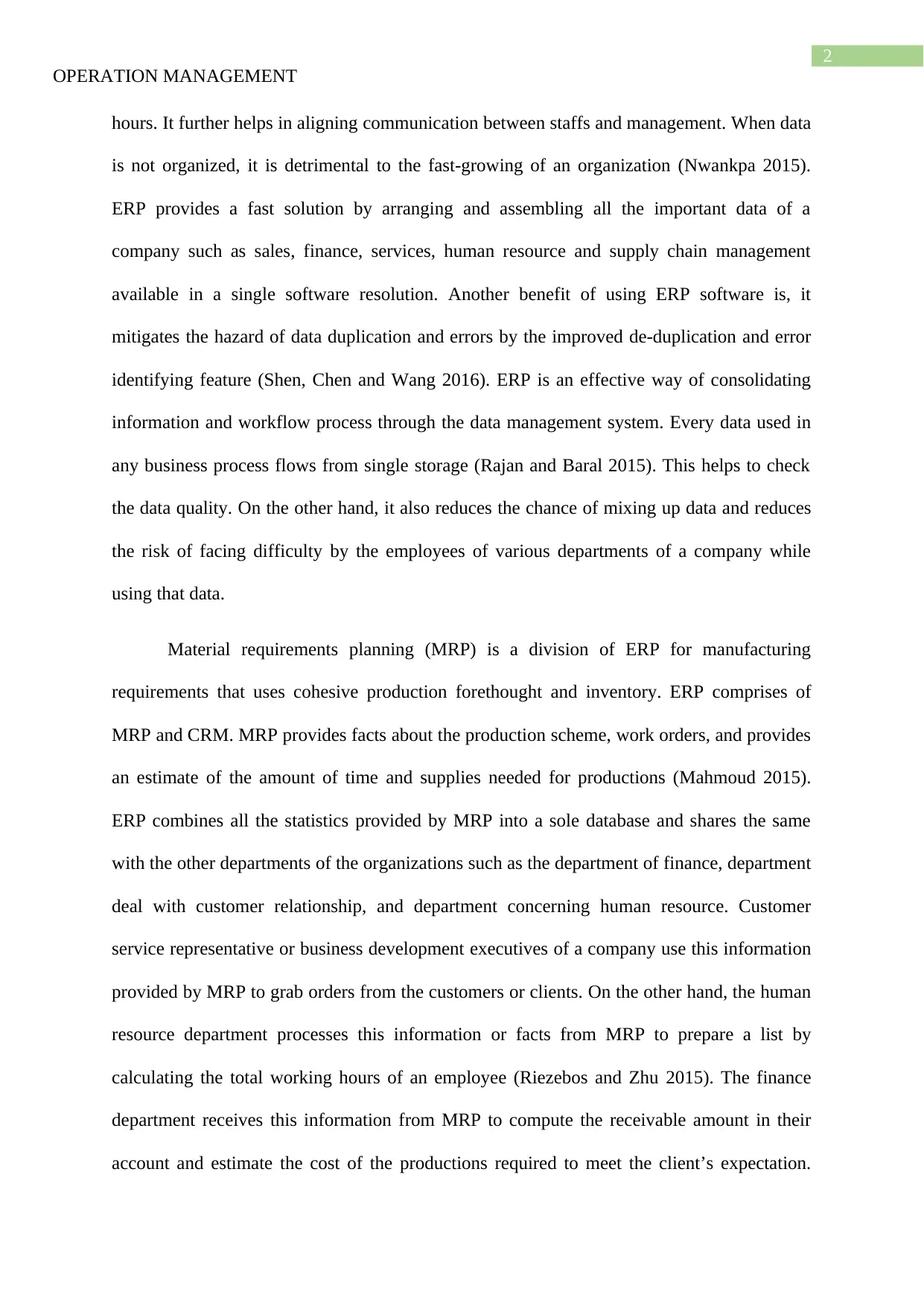
2
OPERATION MANAGEMENT
hours. It further helps in aligning communication between staffs and management. When data
is not organized, it is detrimental to the fast-growing of an organization (Nwankpa 2015).
ERP provides a fast solution by arranging and assembling all the important data of a
company such as sales, finance, services, human resource and supply chain management
available in a single software resolution. Another benefit of using ERP software is, it
mitigates the hazard of data duplication and errors by the improved de-duplication and error
identifying feature (Shen, Chen and Wang 2016). ERP is an effective way of consolidating
information and workflow process through the data management system. Every data used in
any business process flows from single storage (Rajan and Baral 2015). This helps to check
the data quality. On the other hand, it also reduces the chance of mixing up data and reduces
the risk of facing difficulty by the employees of various departments of a company while
using that data.
Material requirements planning (MRP) is a division of ERP for manufacturing
requirements that uses cohesive production forethought and inventory. ERP comprises of
MRP and CRM. MRP provides facts about the production scheme, work orders, and provides
an estimate of the amount of time and supplies needed for productions (Mahmoud 2015).
ERP combines all the statistics provided by MRP into a sole database and shares the same
with the other departments of the organizations such as the department of finance, department
deal with customer relationship, and department concerning human resource. Customer
service representative or business development executives of a company use this information
provided by MRP to grab orders from the customers or clients. On the other hand, the human
resource department processes this information or facts from MRP to prepare a list by
calculating the total working hours of an employee (Riezebos and Zhu 2015). The finance
department receives this information from MRP to compute the receivable amount in their
account and estimate the cost of the productions required to meet the client’s expectation.
OPERATION MANAGEMENT
hours. It further helps in aligning communication between staffs and management. When data
is not organized, it is detrimental to the fast-growing of an organization (Nwankpa 2015).
ERP provides a fast solution by arranging and assembling all the important data of a
company such as sales, finance, services, human resource and supply chain management
available in a single software resolution. Another benefit of using ERP software is, it
mitigates the hazard of data duplication and errors by the improved de-duplication and error
identifying feature (Shen, Chen and Wang 2016). ERP is an effective way of consolidating
information and workflow process through the data management system. Every data used in
any business process flows from single storage (Rajan and Baral 2015). This helps to check
the data quality. On the other hand, it also reduces the chance of mixing up data and reduces
the risk of facing difficulty by the employees of various departments of a company while
using that data.
Material requirements planning (MRP) is a division of ERP for manufacturing
requirements that uses cohesive production forethought and inventory. ERP comprises of
MRP and CRM. MRP provides facts about the production scheme, work orders, and provides
an estimate of the amount of time and supplies needed for productions (Mahmoud 2015).
ERP combines all the statistics provided by MRP into a sole database and shares the same
with the other departments of the organizations such as the department of finance, department
deal with customer relationship, and department concerning human resource. Customer
service representative or business development executives of a company use this information
provided by MRP to grab orders from the customers or clients. On the other hand, the human
resource department processes this information or facts from MRP to prepare a list by
calculating the total working hours of an employee (Riezebos and Zhu 2015). The finance
department receives this information from MRP to compute the receivable amount in their
account and estimate the cost of the productions required to meet the client’s expectation.
⊘ This is a preview!⊘
Do you want full access?
Subscribe today to unlock all pages.

Trusted by 1+ million students worldwide
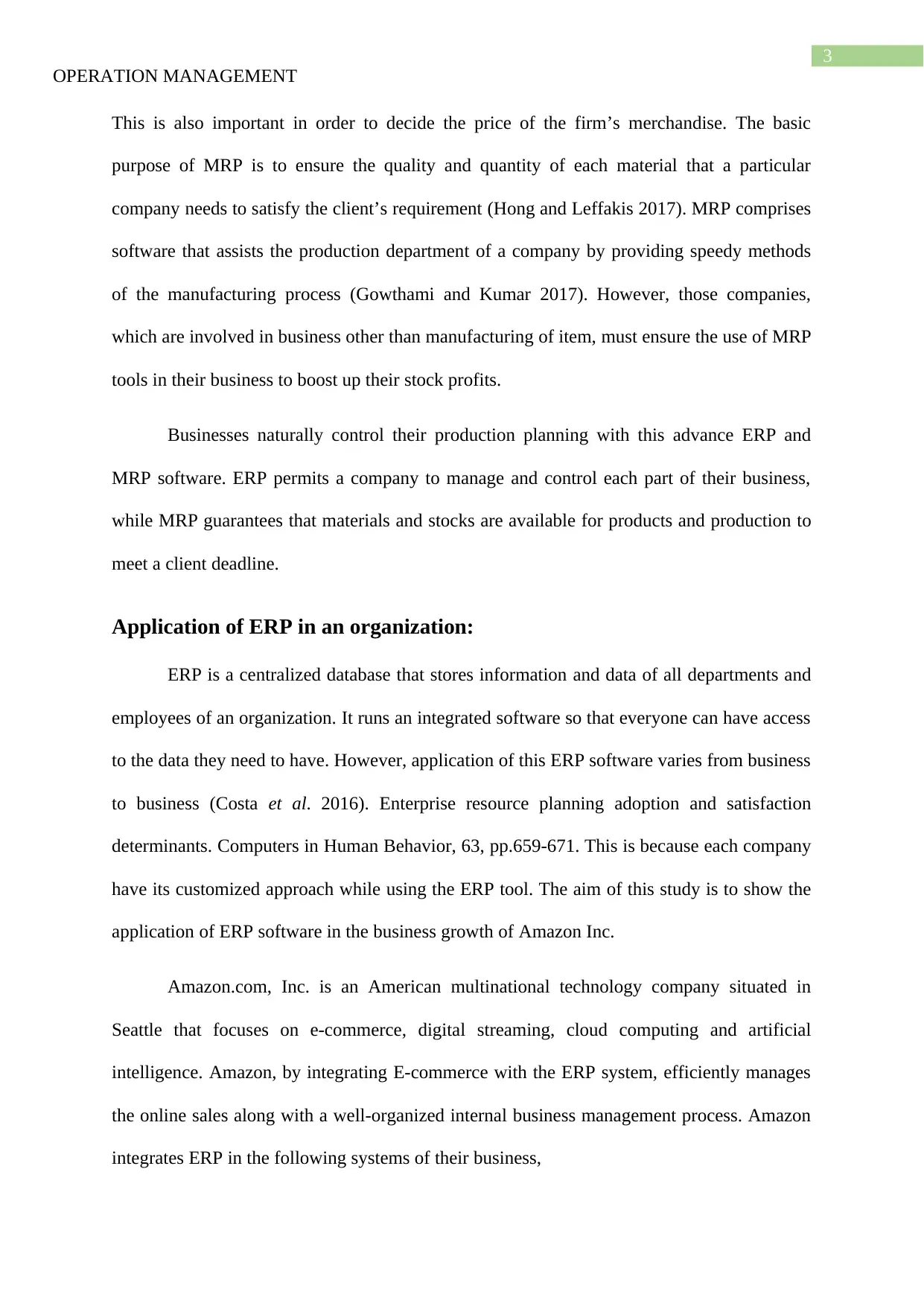
3
OPERATION MANAGEMENT
This is also important in order to decide the price of the firm’s merchandise. The basic
purpose of MRP is to ensure the quality and quantity of each material that a particular
company needs to satisfy the client’s requirement (Hong and Leffakis 2017). MRP comprises
software that assists the production department of a company by providing speedy methods
of the manufacturing process (Gowthami and Kumar 2017). However, those companies,
which are involved in business other than manufacturing of item, must ensure the use of MRP
tools in their business to boost up their stock profits.
Businesses naturally control their production planning with this advance ERP and
MRP software. ERP permits a company to manage and control each part of their business,
while MRP guarantees that materials and stocks are available for products and production to
meet a client deadline.
Application of ERP in an organization:
ERP is a centralized database that stores information and data of all departments and
employees of an organization. It runs an integrated software so that everyone can have access
to the data they need to have. However, application of this ERP software varies from business
to business (Costa et al. 2016). Enterprise resource planning adoption and satisfaction
determinants. Computers in Human Behavior, 63, pp.659-671. This is because each company
have its customized approach while using the ERP tool. The aim of this study is to show the
application of ERP software in the business growth of Amazon Inc.
Amazon.com, Inc. is an American multinational technology company situated in
Seattle that focuses on e-commerce, digital streaming, cloud computing and artificial
intelligence. Amazon, by integrating E-commerce with the ERP system, efficiently manages
the online sales along with a well-organized internal business management process. Amazon
integrates ERP in the following systems of their business,
OPERATION MANAGEMENT
This is also important in order to decide the price of the firm’s merchandise. The basic
purpose of MRP is to ensure the quality and quantity of each material that a particular
company needs to satisfy the client’s requirement (Hong and Leffakis 2017). MRP comprises
software that assists the production department of a company by providing speedy methods
of the manufacturing process (Gowthami and Kumar 2017). However, those companies,
which are involved in business other than manufacturing of item, must ensure the use of MRP
tools in their business to boost up their stock profits.
Businesses naturally control their production planning with this advance ERP and
MRP software. ERP permits a company to manage and control each part of their business,
while MRP guarantees that materials and stocks are available for products and production to
meet a client deadline.
Application of ERP in an organization:
ERP is a centralized database that stores information and data of all departments and
employees of an organization. It runs an integrated software so that everyone can have access
to the data they need to have. However, application of this ERP software varies from business
to business (Costa et al. 2016). Enterprise resource planning adoption and satisfaction
determinants. Computers in Human Behavior, 63, pp.659-671. This is because each company
have its customized approach while using the ERP tool. The aim of this study is to show the
application of ERP software in the business growth of Amazon Inc.
Amazon.com, Inc. is an American multinational technology company situated in
Seattle that focuses on e-commerce, digital streaming, cloud computing and artificial
intelligence. Amazon, by integrating E-commerce with the ERP system, efficiently manages
the online sales along with a well-organized internal business management process. Amazon
integrates ERP in the following systems of their business,
Paraphrase This Document
Need a fresh take? Get an instant paraphrase of this document with our AI Paraphraser
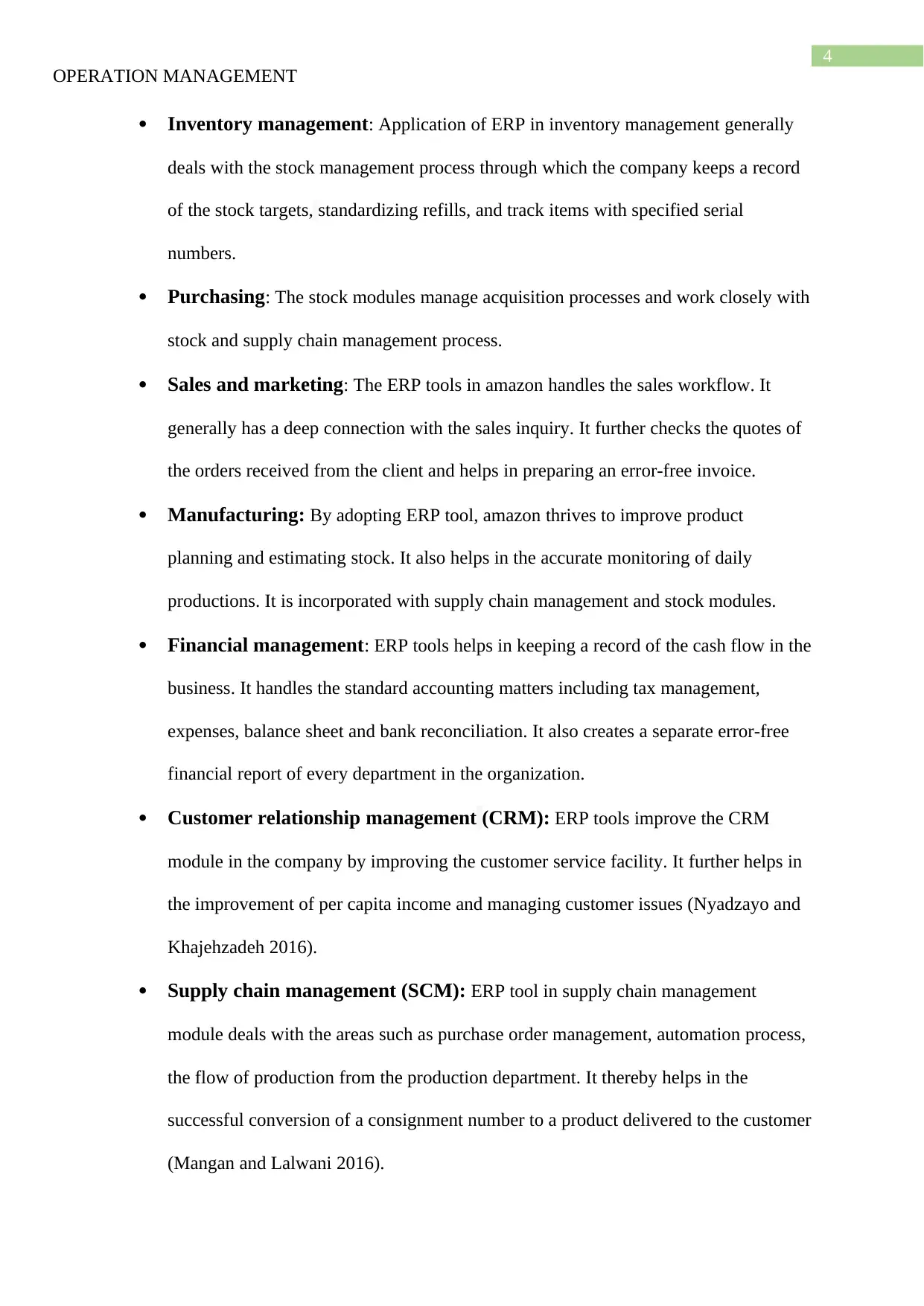
4
OPERATION MANAGEMENT
Inventory management: Application of ERP in inventory management generally
deals with the stock management process through which the company keeps a record
of the stock targets, standardizing refills, and track items with specified serial
numbers.
Purchasing: The stock modules manage acquisition processes and work closely with
stock and supply chain management process.
Sales and marketing: The ERP tools in amazon handles the sales workflow. It
generally has a deep connection with the sales inquiry. It further checks the quotes of
the orders received from the client and helps in preparing an error-free invoice.
Manufacturing: By adopting ERP tool, amazon thrives to improve product
planning and estimating stock. It also helps in the accurate monitoring of daily
productions. It is incorporated with supply chain management and stock modules.
Financial management: ERP tools helps in keeping a record of the cash flow in the
business. It handles the standard accounting matters including tax management,
expenses, balance sheet and bank reconciliation. It also creates a separate error-free
financial report of every department in the organization.
Customer relationship management (CRM): ERP tools improve the CRM
module in the company by improving the customer service facility. It further helps in
the improvement of per capita income and managing customer issues (Nyadzayo and
Khajehzadeh 2016).
Supply chain management (SCM): ERP tool in supply chain management
module deals with the areas such as purchase order management, automation process,
the flow of production from the production department. It thereby helps in the
successful conversion of a consignment number to a product delivered to the customer
(Mangan and Lalwani 2016).
OPERATION MANAGEMENT
Inventory management: Application of ERP in inventory management generally
deals with the stock management process through which the company keeps a record
of the stock targets, standardizing refills, and track items with specified serial
numbers.
Purchasing: The stock modules manage acquisition processes and work closely with
stock and supply chain management process.
Sales and marketing: The ERP tools in amazon handles the sales workflow. It
generally has a deep connection with the sales inquiry. It further checks the quotes of
the orders received from the client and helps in preparing an error-free invoice.
Manufacturing: By adopting ERP tool, amazon thrives to improve product
planning and estimating stock. It also helps in the accurate monitoring of daily
productions. It is incorporated with supply chain management and stock modules.
Financial management: ERP tools helps in keeping a record of the cash flow in the
business. It handles the standard accounting matters including tax management,
expenses, balance sheet and bank reconciliation. It also creates a separate error-free
financial report of every department in the organization.
Customer relationship management (CRM): ERP tools improve the CRM
module in the company by improving the customer service facility. It further helps in
the improvement of per capita income and managing customer issues (Nyadzayo and
Khajehzadeh 2016).
Supply chain management (SCM): ERP tool in supply chain management
module deals with the areas such as purchase order management, automation process,
the flow of production from the production department. It thereby helps in the
successful conversion of a consignment number to a product delivered to the customer
(Mangan and Lalwani 2016).
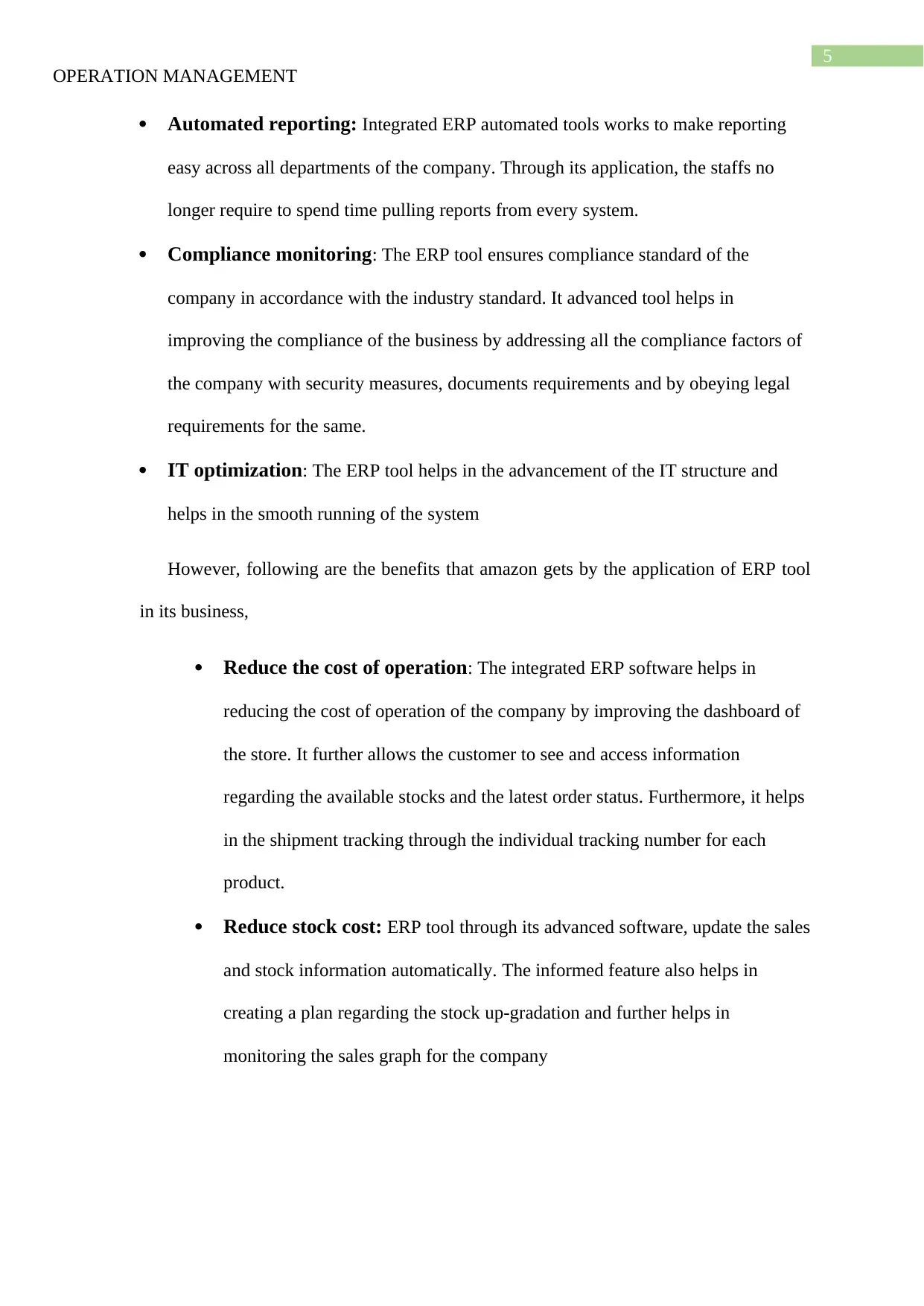
5
OPERATION MANAGEMENT
Automated reporting: Integrated ERP automated tools works to make reporting
easy across all departments of the company. Through its application, the staffs no
longer require to spend time pulling reports from every system.
Compliance monitoring: The ERP tool ensures compliance standard of the
company in accordance with the industry standard. It advanced tool helps in
improving the compliance of the business by addressing all the compliance factors of
the company with security measures, documents requirements and by obeying legal
requirements for the same.
IT optimization: The ERP tool helps in the advancement of the IT structure and
helps in the smooth running of the system
However, following are the benefits that amazon gets by the application of ERP tool
in its business,
Reduce the cost of operation: The integrated ERP software helps in
reducing the cost of operation of the company by improving the dashboard of
the store. It further allows the customer to see and access information
regarding the available stocks and the latest order status. Furthermore, it helps
in the shipment tracking through the individual tracking number for each
product.
Reduce stock cost: ERP tool through its advanced software, update the sales
and stock information automatically. The informed feature also helps in
creating a plan regarding the stock up-gradation and further helps in
monitoring the sales graph for the company
OPERATION MANAGEMENT
Automated reporting: Integrated ERP automated tools works to make reporting
easy across all departments of the company. Through its application, the staffs no
longer require to spend time pulling reports from every system.
Compliance monitoring: The ERP tool ensures compliance standard of the
company in accordance with the industry standard. It advanced tool helps in
improving the compliance of the business by addressing all the compliance factors of
the company with security measures, documents requirements and by obeying legal
requirements for the same.
IT optimization: The ERP tool helps in the advancement of the IT structure and
helps in the smooth running of the system
However, following are the benefits that amazon gets by the application of ERP tool
in its business,
Reduce the cost of operation: The integrated ERP software helps in
reducing the cost of operation of the company by improving the dashboard of
the store. It further allows the customer to see and access information
regarding the available stocks and the latest order status. Furthermore, it helps
in the shipment tracking through the individual tracking number for each
product.
Reduce stock cost: ERP tool through its advanced software, update the sales
and stock information automatically. The informed feature also helps in
creating a plan regarding the stock up-gradation and further helps in
monitoring the sales graph for the company
⊘ This is a preview!⊘
Do you want full access?
Subscribe today to unlock all pages.

Trusted by 1+ million students worldwide
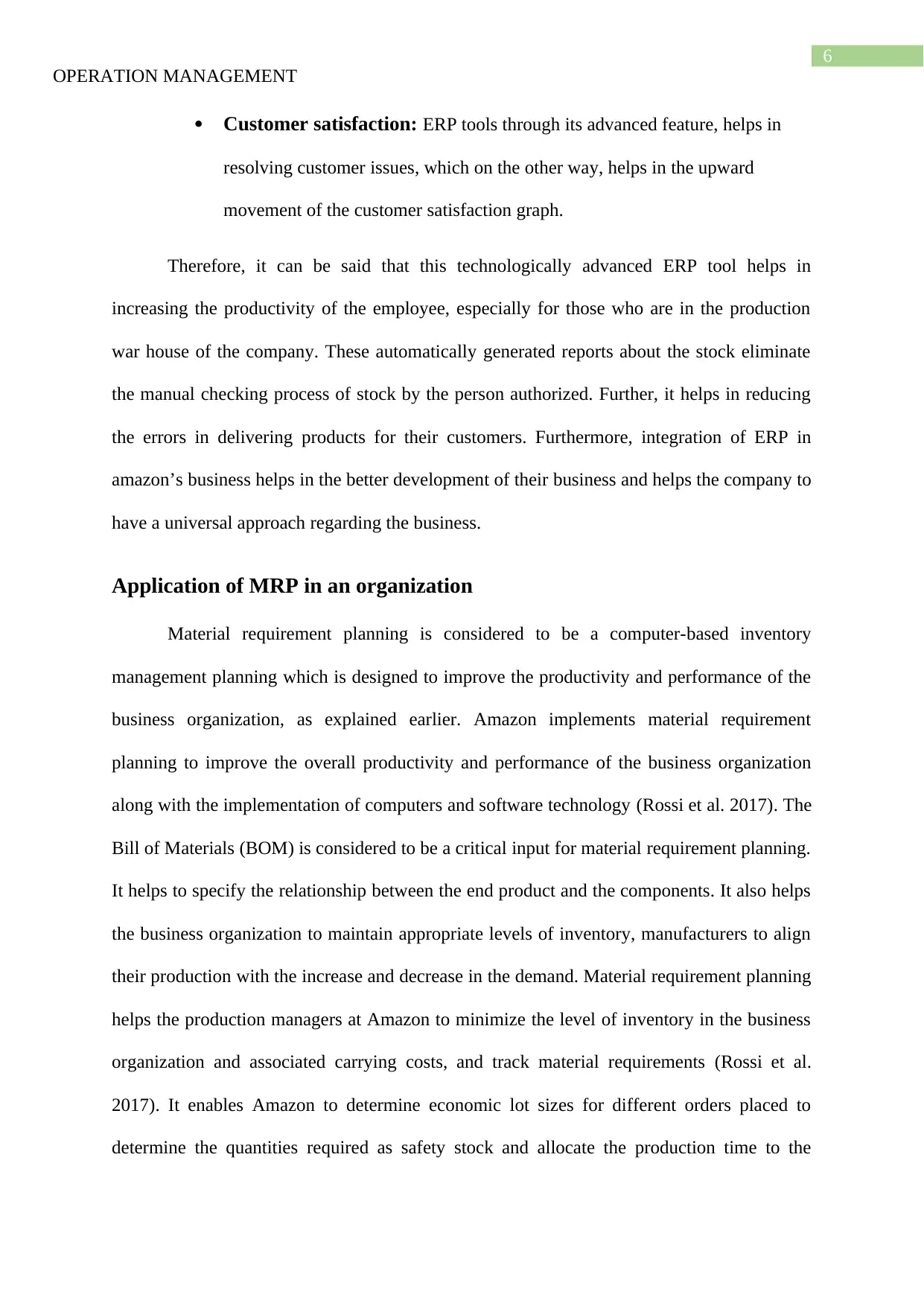
6
OPERATION MANAGEMENT
Customer satisfaction: ERP tools through its advanced feature, helps in
resolving customer issues, which on the other way, helps in the upward
movement of the customer satisfaction graph.
Therefore, it can be said that this technologically advanced ERP tool helps in
increasing the productivity of the employee, especially for those who are in the production
war house of the company. These automatically generated reports about the stock eliminate
the manual checking process of stock by the person authorized. Further, it helps in reducing
the errors in delivering products for their customers. Furthermore, integration of ERP in
amazon’s business helps in the better development of their business and helps the company to
have a universal approach regarding the business.
Application of MRP in an organization
Material requirement planning is considered to be a computer-based inventory
management planning which is designed to improve the productivity and performance of the
business organization, as explained earlier. Amazon implements material requirement
planning to improve the overall productivity and performance of the business organization
along with the implementation of computers and software technology (Rossi et al. 2017). The
Bill of Materials (BOM) is considered to be a critical input for material requirement planning.
It helps to specify the relationship between the end product and the components. It also helps
the business organization to maintain appropriate levels of inventory, manufacturers to align
their production with the increase and decrease in the demand. Material requirement planning
helps the production managers at Amazon to minimize the level of inventory in the business
organization and associated carrying costs, and track material requirements (Rossi et al.
2017). It enables Amazon to determine economic lot sizes for different orders placed to
determine the quantities required as safety stock and allocate the production time to the
OPERATION MANAGEMENT
Customer satisfaction: ERP tools through its advanced feature, helps in
resolving customer issues, which on the other way, helps in the upward
movement of the customer satisfaction graph.
Therefore, it can be said that this technologically advanced ERP tool helps in
increasing the productivity of the employee, especially for those who are in the production
war house of the company. These automatically generated reports about the stock eliminate
the manual checking process of stock by the person authorized. Further, it helps in reducing
the errors in delivering products for their customers. Furthermore, integration of ERP in
amazon’s business helps in the better development of their business and helps the company to
have a universal approach regarding the business.
Application of MRP in an organization
Material requirement planning is considered to be a computer-based inventory
management planning which is designed to improve the productivity and performance of the
business organization, as explained earlier. Amazon implements material requirement
planning to improve the overall productivity and performance of the business organization
along with the implementation of computers and software technology (Rossi et al. 2017). The
Bill of Materials (BOM) is considered to be a critical input for material requirement planning.
It helps to specify the relationship between the end product and the components. It also helps
the business organization to maintain appropriate levels of inventory, manufacturers to align
their production with the increase and decrease in the demand. Material requirement planning
helps the production managers at Amazon to minimize the level of inventory in the business
organization and associated carrying costs, and track material requirements (Rossi et al.
2017). It enables Amazon to determine economic lot sizes for different orders placed to
determine the quantities required as safety stock and allocate the production time to the
Paraphrase This Document
Need a fresh take? Get an instant paraphrase of this document with our AI Paraphraser
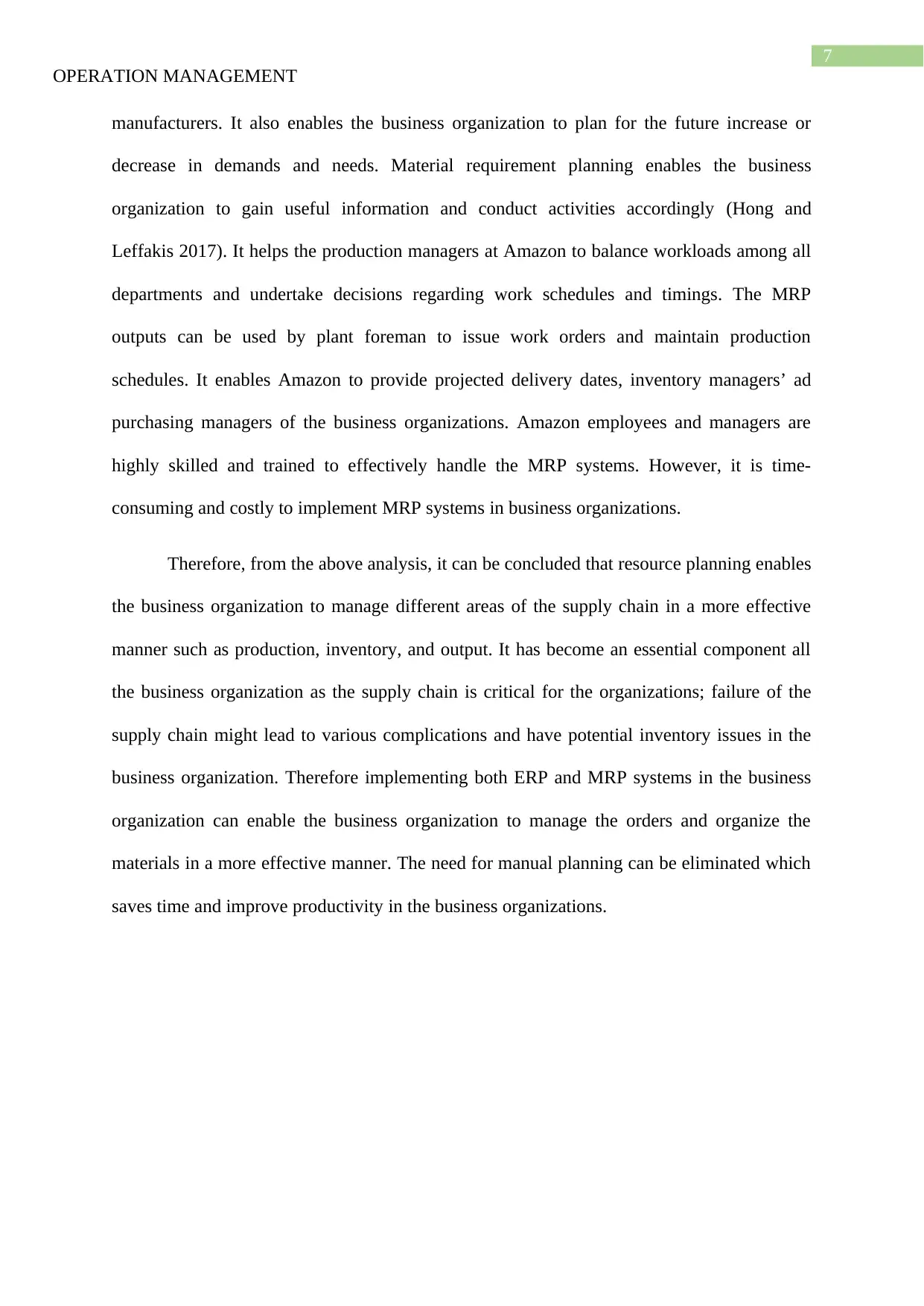
7
OPERATION MANAGEMENT
manufacturers. It also enables the business organization to plan for the future increase or
decrease in demands and needs. Material requirement planning enables the business
organization to gain useful information and conduct activities accordingly (Hong and
Leffakis 2017). It helps the production managers at Amazon to balance workloads among all
departments and undertake decisions regarding work schedules and timings. The MRP
outputs can be used by plant foreman to issue work orders and maintain production
schedules. It enables Amazon to provide projected delivery dates, inventory managers’ ad
purchasing managers of the business organizations. Amazon employees and managers are
highly skilled and trained to effectively handle the MRP systems. However, it is time-
consuming and costly to implement MRP systems in business organizations.
Therefore, from the above analysis, it can be concluded that resource planning enables
the business organization to manage different areas of the supply chain in a more effective
manner such as production, inventory, and output. It has become an essential component all
the business organization as the supply chain is critical for the organizations; failure of the
supply chain might lead to various complications and have potential inventory issues in the
business organization. Therefore implementing both ERP and MRP systems in the business
organization can enable the business organization to manage the orders and organize the
materials in a more effective manner. The need for manual planning can be eliminated which
saves time and improve productivity in the business organizations.
OPERATION MANAGEMENT
manufacturers. It also enables the business organization to plan for the future increase or
decrease in demands and needs. Material requirement planning enables the business
organization to gain useful information and conduct activities accordingly (Hong and
Leffakis 2017). It helps the production managers at Amazon to balance workloads among all
departments and undertake decisions regarding work schedules and timings. The MRP
outputs can be used by plant foreman to issue work orders and maintain production
schedules. It enables Amazon to provide projected delivery dates, inventory managers’ ad
purchasing managers of the business organizations. Amazon employees and managers are
highly skilled and trained to effectively handle the MRP systems. However, it is time-
consuming and costly to implement MRP systems in business organizations.
Therefore, from the above analysis, it can be concluded that resource planning enables
the business organization to manage different areas of the supply chain in a more effective
manner such as production, inventory, and output. It has become an essential component all
the business organization as the supply chain is critical for the organizations; failure of the
supply chain might lead to various complications and have potential inventory issues in the
business organization. Therefore implementing both ERP and MRP systems in the business
organization can enable the business organization to manage the orders and organize the
materials in a more effective manner. The need for manual planning can be eliminated which
saves time and improve productivity in the business organizations.
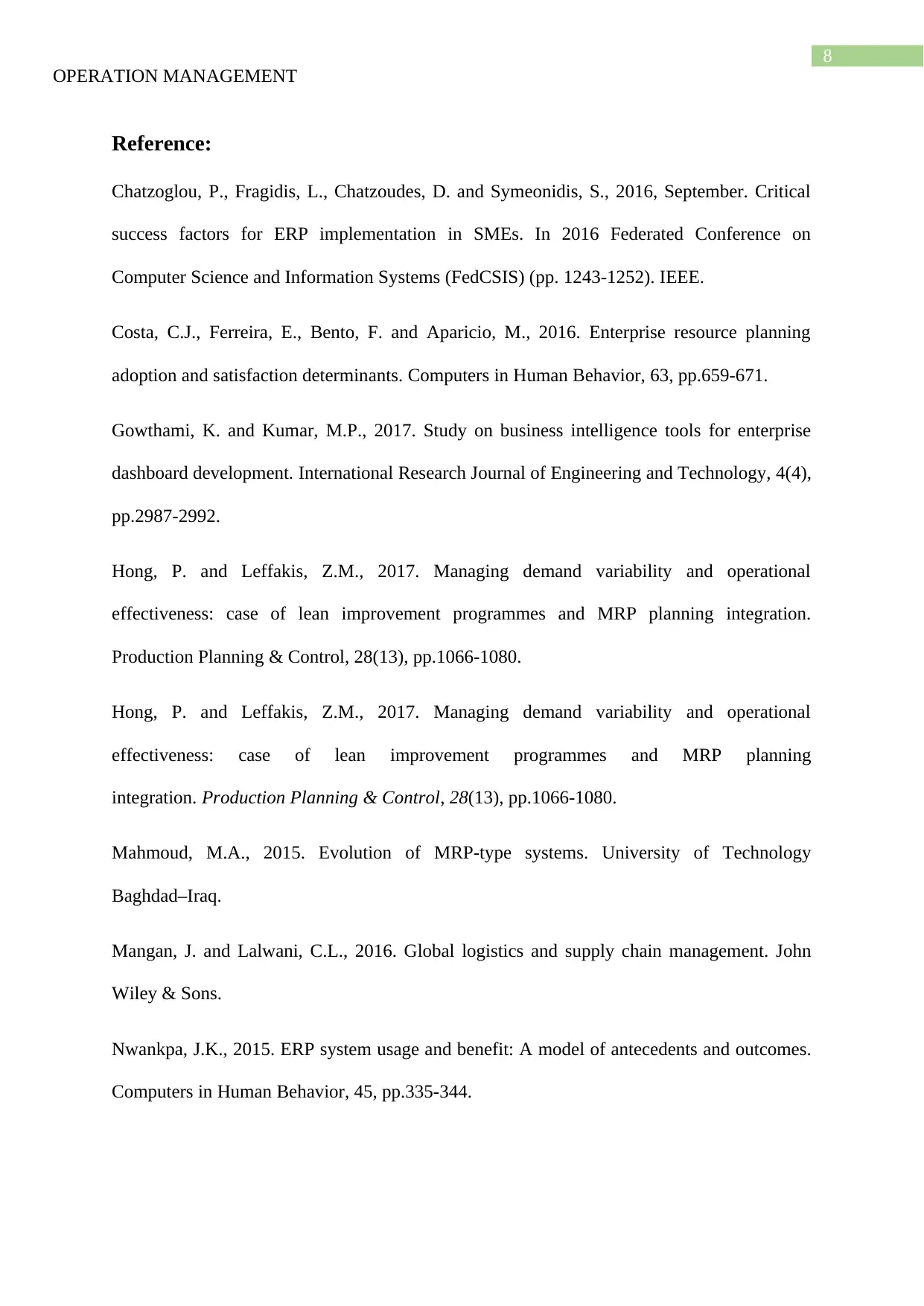
8
OPERATION MANAGEMENT
Reference:
Chatzoglou, P., Fragidis, L., Chatzoudes, D. and Symeonidis, S., 2016, September. Critical
success factors for ERP implementation in SMEs. In 2016 Federated Conference on
Computer Science and Information Systems (FedCSIS) (pp. 1243-1252). IEEE.
Costa, C.J., Ferreira, E., Bento, F. and Aparicio, M., 2016. Enterprise resource planning
adoption and satisfaction determinants. Computers in Human Behavior, 63, pp.659-671.
Gowthami, K. and Kumar, M.P., 2017. Study on business intelligence tools for enterprise
dashboard development. International Research Journal of Engineering and Technology, 4(4),
pp.2987-2992.
Hong, P. and Leffakis, Z.M., 2017. Managing demand variability and operational
effectiveness: case of lean improvement programmes and MRP planning integration.
Production Planning & Control, 28(13), pp.1066-1080.
Hong, P. and Leffakis, Z.M., 2017. Managing demand variability and operational
effectiveness: case of lean improvement programmes and MRP planning
integration. Production Planning & Control, 28(13), pp.1066-1080.
Mahmoud, M.A., 2015. Evolution of MRP-type systems. University of Technology
Baghdad–Iraq.
Mangan, J. and Lalwani, C.L., 2016. Global logistics and supply chain management. John
Wiley & Sons.
Nwankpa, J.K., 2015. ERP system usage and benefit: A model of antecedents and outcomes.
Computers in Human Behavior, 45, pp.335-344.
OPERATION MANAGEMENT
Reference:
Chatzoglou, P., Fragidis, L., Chatzoudes, D. and Symeonidis, S., 2016, September. Critical
success factors for ERP implementation in SMEs. In 2016 Federated Conference on
Computer Science and Information Systems (FedCSIS) (pp. 1243-1252). IEEE.
Costa, C.J., Ferreira, E., Bento, F. and Aparicio, M., 2016. Enterprise resource planning
adoption and satisfaction determinants. Computers in Human Behavior, 63, pp.659-671.
Gowthami, K. and Kumar, M.P., 2017. Study on business intelligence tools for enterprise
dashboard development. International Research Journal of Engineering and Technology, 4(4),
pp.2987-2992.
Hong, P. and Leffakis, Z.M., 2017. Managing demand variability and operational
effectiveness: case of lean improvement programmes and MRP planning integration.
Production Planning & Control, 28(13), pp.1066-1080.
Hong, P. and Leffakis, Z.M., 2017. Managing demand variability and operational
effectiveness: case of lean improvement programmes and MRP planning
integration. Production Planning & Control, 28(13), pp.1066-1080.
Mahmoud, M.A., 2015. Evolution of MRP-type systems. University of Technology
Baghdad–Iraq.
Mangan, J. and Lalwani, C.L., 2016. Global logistics and supply chain management. John
Wiley & Sons.
Nwankpa, J.K., 2015. ERP system usage and benefit: A model of antecedents and outcomes.
Computers in Human Behavior, 45, pp.335-344.
⊘ This is a preview!⊘
Do you want full access?
Subscribe today to unlock all pages.

Trusted by 1+ million students worldwide
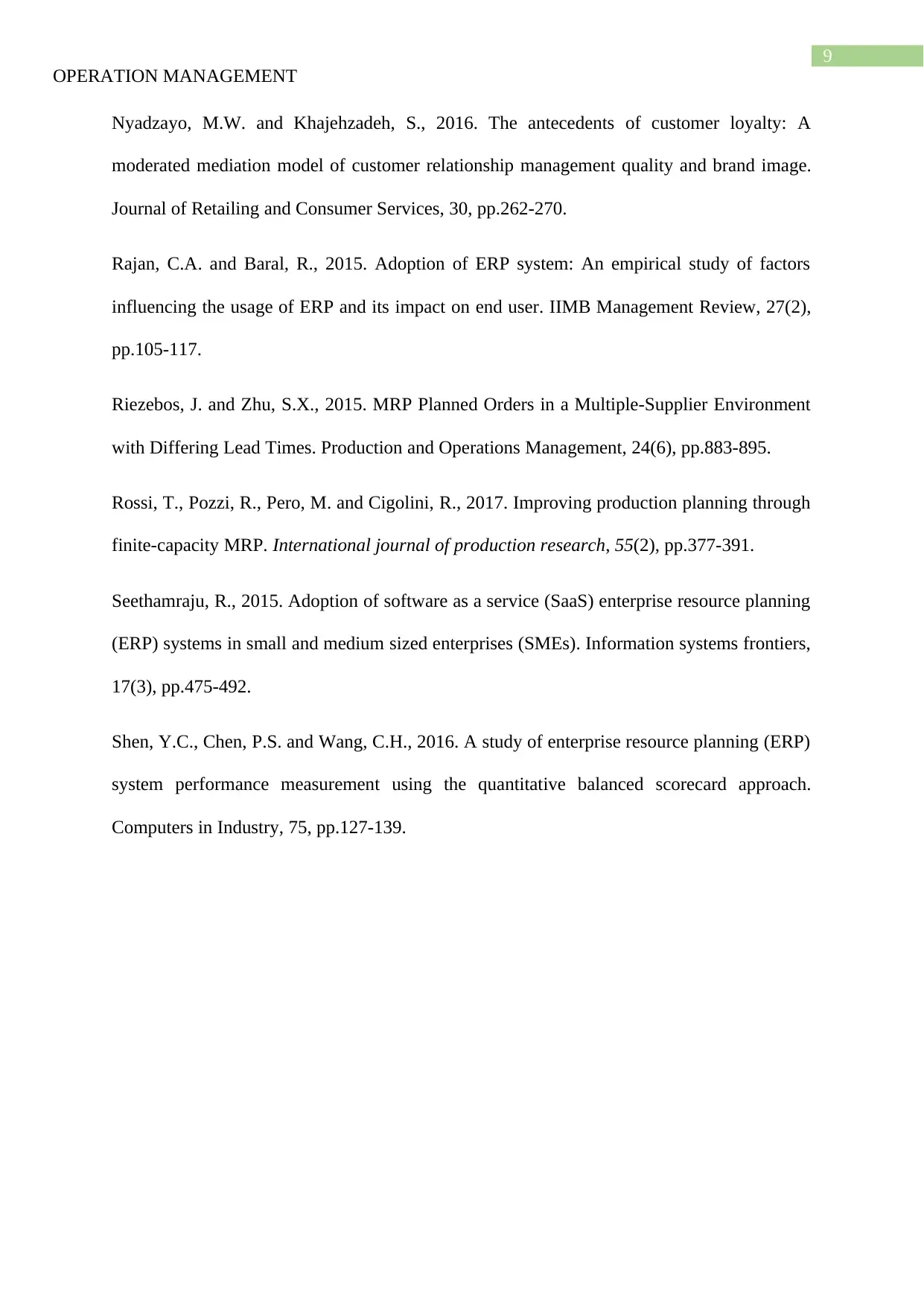
9
OPERATION MANAGEMENT
Nyadzayo, M.W. and Khajehzadeh, S., 2016. The antecedents of customer loyalty: A
moderated mediation model of customer relationship management quality and brand image.
Journal of Retailing and Consumer Services, 30, pp.262-270.
Rajan, C.A. and Baral, R., 2015. Adoption of ERP system: An empirical study of factors
influencing the usage of ERP and its impact on end user. IIMB Management Review, 27(2),
pp.105-117.
Riezebos, J. and Zhu, S.X., 2015. MRP Planned Orders in a Multiple‐Supplier Environment
with Differing Lead Times. Production and Operations Management, 24(6), pp.883-895.
Rossi, T., Pozzi, R., Pero, M. and Cigolini, R., 2017. Improving production planning through
finite-capacity MRP. International journal of production research, 55(2), pp.377-391.
Seethamraju, R., 2015. Adoption of software as a service (SaaS) enterprise resource planning
(ERP) systems in small and medium sized enterprises (SMEs). Information systems frontiers,
17(3), pp.475-492.
Shen, Y.C., Chen, P.S. and Wang, C.H., 2016. A study of enterprise resource planning (ERP)
system performance measurement using the quantitative balanced scorecard approach.
Computers in Industry, 75, pp.127-139.
OPERATION MANAGEMENT
Nyadzayo, M.W. and Khajehzadeh, S., 2016. The antecedents of customer loyalty: A
moderated mediation model of customer relationship management quality and brand image.
Journal of Retailing and Consumer Services, 30, pp.262-270.
Rajan, C.A. and Baral, R., 2015. Adoption of ERP system: An empirical study of factors
influencing the usage of ERP and its impact on end user. IIMB Management Review, 27(2),
pp.105-117.
Riezebos, J. and Zhu, S.X., 2015. MRP Planned Orders in a Multiple‐Supplier Environment
with Differing Lead Times. Production and Operations Management, 24(6), pp.883-895.
Rossi, T., Pozzi, R., Pero, M. and Cigolini, R., 2017. Improving production planning through
finite-capacity MRP. International journal of production research, 55(2), pp.377-391.
Seethamraju, R., 2015. Adoption of software as a service (SaaS) enterprise resource planning
(ERP) systems in small and medium sized enterprises (SMEs). Information systems frontiers,
17(3), pp.475-492.
Shen, Y.C., Chen, P.S. and Wang, C.H., 2016. A study of enterprise resource planning (ERP)
system performance measurement using the quantitative balanced scorecard approach.
Computers in Industry, 75, pp.127-139.
1 out of 10
Related Documents
Your All-in-One AI-Powered Toolkit for Academic Success.
+13062052269
info@desklib.com
Available 24*7 on WhatsApp / Email
![[object Object]](/_next/static/media/star-bottom.7253800d.svg)
Unlock your academic potential
Copyright © 2020–2025 A2Z Services. All Rights Reserved. Developed and managed by ZUCOL.




